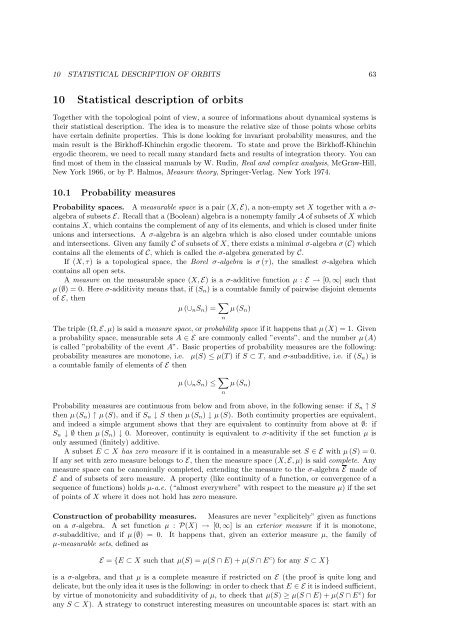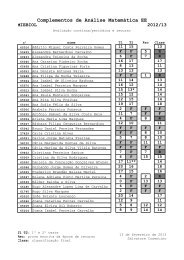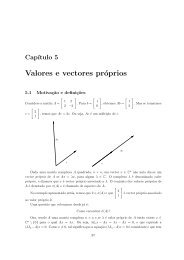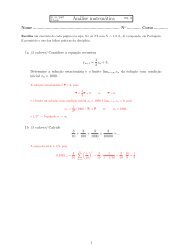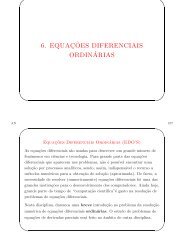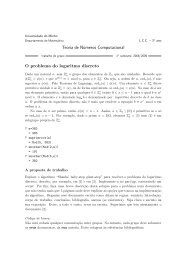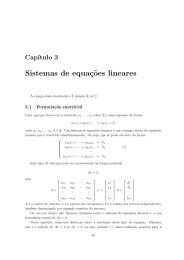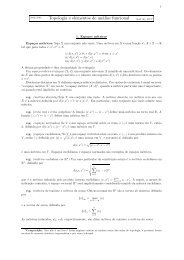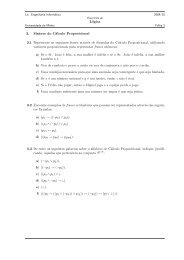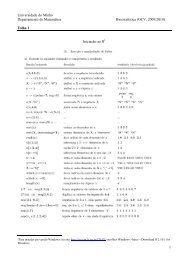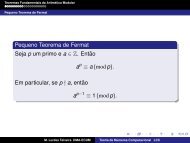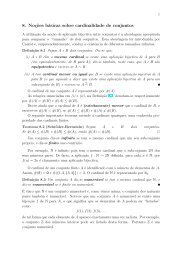My title - Departamento de Matemática da Universidade do Minho
My title - Departamento de Matemática da Universidade do Minho
My title - Departamento de Matemática da Universidade do Minho
You also want an ePaper? Increase the reach of your titles
YUMPU automatically turns print PDFs into web optimized ePapers that Google loves.
10 STATISTICAL DESCRIPTION OF ORBITS 63<br />
10 Statistical <strong>de</strong>scription of orbits<br />
Together with the topological point of view, a source of informations about dynamical systems is<br />
their statistical <strong>de</strong>scription. The i<strong>de</strong>a is to measure the relative size of those points whose orbits<br />
have certain <strong>de</strong>finite properties. This is <strong>do</strong>ne looking for invariant probability measures, and the<br />
main result is the Birkhoff-Khinchin ergodic theorem. To state and prove the Birkhoff-Khinchin<br />
ergodic theorem, we need to recall many stan<strong>da</strong>rd facts and results of integration theory. You can<br />
find most of them in the classical manuals by W. Rudin, Real and complex analysis, McGraw-Hill,<br />
New York 1966, or by P. Halmos, Measure theory, Springer-Verlag. New York 1974.<br />
10.1 Probability measures<br />
Probability spaces. A measurable space is a pair (X, E), a non-empty set X together with a σ-<br />
algebra of subsets E. Recall that a (Boolean) algebra is a nonempty family A of subsets of X which<br />
contains X, which contains the complement of any of its elements, and which is closed un<strong>de</strong>r finite<br />
unions and intersections. A σ-algebra is an algebra which is also closed un<strong>de</strong>r countable unions<br />
and intersections. Given any family C of subsets of X, there exists a minimal σ-algebra σ (C) which<br />
contains all the elements of C, which is called the σ-algebra generated by C.<br />
If (X, τ) is a topological space, the Borel σ-algebra is σ (τ), the smallest σ-algebra which<br />
contains all open sets.<br />
A measure on the measurable space (X, E) is a σ-additive function µ : E → [0, ∞] such that<br />
µ (∅) = 0. Here σ-additivity means that, if (S n ) is a countable family of pairwise disjoint elements<br />
of E, then<br />
µ (∪ n S n ) = ∑ µ (S n )<br />
n<br />
The triple (Ω, E, µ) is said a measure space, or probability space if it happens that µ (X) = 1. Given<br />
a probability space, measurable sets A ∈ E are commonly called ”events”, and the number µ (A)<br />
is called ”probability of the event A”. Basic properties of probability measures are the following:<br />
probability measures are monotone, i.e. µ(S) ≤ µ(T ) if S ⊂ T , and σ-subadditive, i.e. if (S n ) is<br />
a countable family of elements of E then<br />
µ (∪ n S n ) ≤ ∑ n<br />
µ (S n )<br />
Probability measures are continuous from below and from above, in the following sense: if S n ↑ S<br />
then µ (S n ) ↑ µ (S), and if S n ↓ S then µ (S n ) ↓ µ (S). Both continuity properties are equivalent,<br />
and in<strong>de</strong>ed a simple argument shows that they are equivalent to continuity from above at ∅: if<br />
S n ↓ ∅ then µ (S n ) ↓ 0. Moreover, continuity is equivalent to σ-aditivity if the set function µ is<br />
only assumed (finitely) additive.<br />
A subset E ⊂ X has zero measure if it is contained in a measurable set S ∈ E with µ (S) = 0.<br />
If any set with zero measure belongs to E, then the measure space (X, E, µ) is said complete. Any<br />
measure space can be canonically completed, extending the measure to the σ-algebra E ma<strong>de</strong> of<br />
E and of subsets of zero measure. A property (like continuity of a function, or convergence of a<br />
sequence of functions) holds µ-a.e. (“almost everywhere” with respect to the measure µ) if the set<br />
of points of X where it <strong>do</strong>es not hold has zero measure.<br />
Construction of probability measures. Measures are never ”explicitely” given as functions<br />
on a σ-algebra. A set function µ : P(X) → [0, ∞] is an exterior measure if it is monotone,<br />
σ-subadditive, and if µ (∅) = 0. It happens that, given an exterior measure µ, the family of<br />
µ-measurable sets, <strong>de</strong>fined as<br />
E = {E ⊂ X such that µ(S) = µ(S ∩ E) + µ(S ∩ E c ) for any S ⊂ X}<br />
is a σ-algebra, and that µ is a complete measure if restricted on E (the proof is quite long and<br />
<strong>de</strong>licate, but the only i<strong>de</strong>a it uses is the following: in or<strong>de</strong>r to check that E ∈ E it is in<strong>de</strong>ed sufficient,<br />
by virtue of monotonicity and subadditivity of µ, to check that µ(S) ≥ µ(S ∩ E) + µ(S ∩ E c ) for<br />
any S ⊂ X). A strategy to construct interesting measures on uncountable spaces is: start with an


